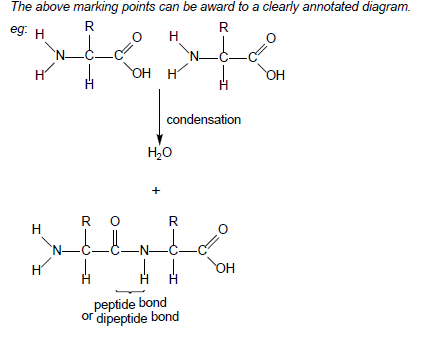Question
In eukaryotes, the chromosomes are located in the nucleus, and the nucleus can divide by
mitosis or meiosis.
(a) Outline the sequence of events that occurs during mitosis.
(b) Describe the processes that occur in the nucleus of a cell during interphase.
(c) Explain how the presence of a Y chromosome in the cells of a human embryo causes it to develop as a male.
Answer/Explanation
Answer:
(a)
a. supercoiling/condensation of chromosomes;
b. breakup of nuclear membrane;
c. growth of spindle/microtubules;
d. attachment of spindle/microtubules to chromosomes/centromeres;
e. chromosomes line up at the equator/middle
f. division of centromeres;
g. separation of sister chromatids/chromosomes
OR
sister chromatids/chromosomes move to opposite poles;
h. reformation of nuclear membranes around chromosomes at each pole;
(b)
a. DNA is replicated;
b. unwinding of the double helix/DNA (by helicase)
OR
supercoiled DNA is relaxed (by gyrase);
c. hydrogen bonds broken
OR
strands separate;
d. synthesis of new strands of DNA (by DNA polymerase);
e. DNA replication occurs semi-conservatively
OR
existing strand used as a template (for a new strand of DNA);
OR
DNA replication is continuous on the leading strand, but discontinuous on the
lagging strand;
f. copying base sequences occurs through complementary base pairing (in both
transcription and replication);
g. DNA is transcribed;
h. synthesis of RNA/mRNA (by RNA polymerase);
i. copy of a gene produced/only one gene transcribed;
j. introns are removed;
k. RNA/mRNA exported/moves to the cytoplasm;
(c)
a. gene/genetic information on Y chromosome causes embryo to develop testes;
b. (developing) testes in embryo secrete testosterone;
c. testosterone causes male genitalia/penis to develop;
Question
The diagram shows the stages in the cell cycle.
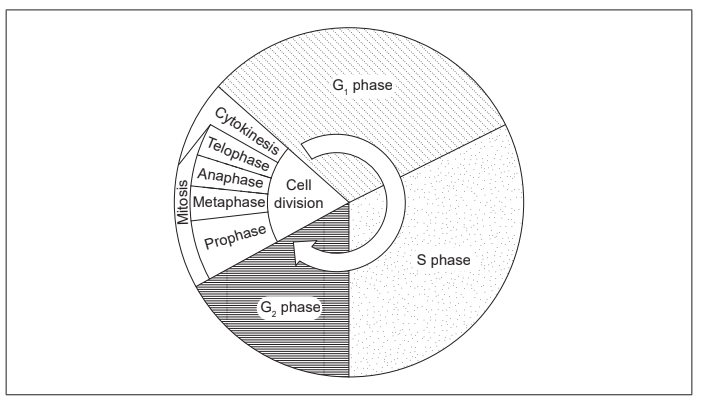
(a) State processes occurring during interphase. [2]
(b) (i) Using the letter C, label the stage on the diagram where chromosome supercoiling occurs. [1]
(ii) Using the letter M, label the stage on the diagram where sister chromatids migrate to opposite poles. [1]
(c) Distinguish between the outcomes of a cell dividing either by mitosis or meiosis. [2]
(d) The mitotic index is an important prognostic tool for predicting the response of cancer cells to chemotherapy. Outline how the mitotic index is calculated. [1]
▶️Answer/Explanation
Ans:
a
a. DNA replication
b. cell growth
c. duplication of organelles/mitochondria / production of microtubules/protein synthesis Accept first two answers only
b
i prophase The stage should be clearly labelled. If more than one stage is shown the candidate does not receive a mark.
ii anaphase The stage should be clearly labelled. If more than one stage is shown the candidate does not receive a mark.
c
a. mitosis produces two daughter cells while meiosis four
b. mitosis produces cells with same number of chromosomes (2n) while in meiosis they are halved (n)
c. mitosis produces body cells but meiosis produces gametes OR mitosis produces genetically identical cells but meiosis does not Allow answers in a table. Reference to both has to be present for the mark
d number of cells (seen under the microscope) undergoing mitosis divided by the total number of cells (observed in sample area) Can be given as a %
Question
The image is an electron micrograph.
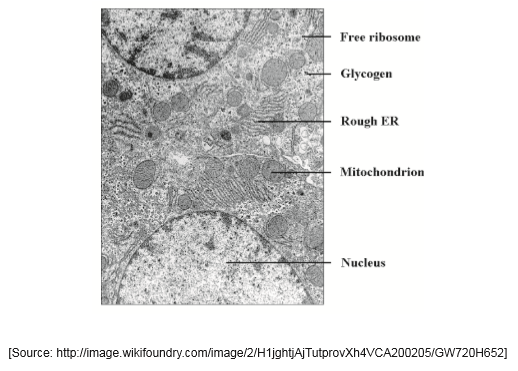
Determine, with a reason, whether the image is of a prokaryotic cell or eukaryotic cell.
(i) State the process that divides one nucleus into two genetically identical nuclei.
(ii) Explain how the cell cycle is controlled.
▶️Answer/Explanation
Markscheme
eukaryotic because nucleus/membrane-bound organelles/named organelle other than ribosome «eg, mitochondria, vesicles» internal membranes «ER»/multicellular
(i) mitosis
(ii)
a. cell cycle is a sequence of stages / cell cycle is G1, S, G2 and mitosis
b. (control of the cell cycle) by cyclins/cyclin
c. levels of cyclins rise (and fall)/fluctuate during the cell cycle/surge at different times/have to reach a certain concentration
d. conditions inside as well as outside the cell affect regulation
e. four cyclins/different cyclins to enter different stages of/events in the cell cycle / cyclins regulate the sequence/timing of the cell cycle / cyclins trigger the next stages
The idea of different cyclins acting at different phases must be clear.
f. cyclin-dependent kinases / cyclins bind to kinases and activate them
g. kinases phosphorylate other proteins
h. phosphorylated proteins perform specific functions in the cell cycle
Question
The diagrams show a virus and a bacterium.
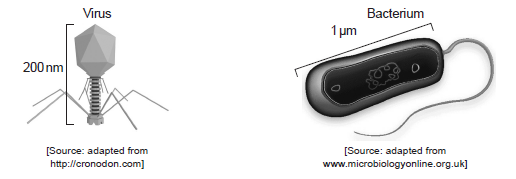
Calculate the magnification of the bacterium.
State the method that bacteria use to divide.
Outline the effectiveness of antibiotics against viruses and bacteria.
Saprotrophic organisms, such as Mucor species, are abundant in soils.
Define saprotrophic organisms.
State one role of saprotrophic organisms in the ecosystem.
▶️Answer/Explanation
Markscheme
45 000(x) or (x)45000 (accept answers in the range of 44000 to 46 000)
binary fission
effective against bacteria, but not viruses
an organism that secretes enzymes in dead organic matter and absorbs its nutrients/products of digestion
decomposer / recycle nutrients / break down organic material into inorganic material
Do not just accept “recycle” alone.
Question
Outline the stages of the cell cycle.
Explain the process of translation in cells.
Outline the production of a dipeptide by a condensation reaction, showing the structure of a generalized dipeptide.
▶️Answer/Explanation
Markscheme
a. interphase is the longest phase;
b. interphase includes G1, S and G2;
c. in G1 and G2 /G phases, cell performs normal functions/protein synthesis/cell grows/organelles are replicated;
d. S/synthesis phase when the DNA replicates;
e. mitosis is when nucleus/genetic material divides;
f. named/described stages of mitosis;
g. cytokinesis: the division of the cytoplasm / formation of two daughter cells;
Award [3 max] if all three stages (interphase, mitosis and cytokinesis) are not mentioned.
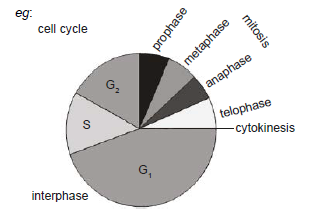
a. translation is the conversion of base sequence on mRNA into an amino acid sequence / OWTTE;
b. messenger/mRNA attaches to ribosome (small unit);
c. many ribosome/polyribosomes bind to same mRNA;
d. (mRNA) carries codons/triplet of bases each coding for one amino acid;
e. transfer/tRNA each have specific anticodon;
f. tRNA carries specific amino acid;
g. tRNA anticodon binds to codon in the mRNA;
h. to corresponding triplet base/codon by complementary base pairing / OWTTE;
i. a second tRNA (anticodon) binds to next codon;
j. two amino acids bind together / peptide linkage is formed;
k. first tRNA detaches;
l. ribosome moves along mRNA;
m. another tRNA binds to next codon;
n. continues until stop codon is reached;
o. stop codon has no corresponding tRNA (anticodon)/amino acid/causes release of polypeptide;
a. condensation is joining together two amino acids to form a dipeptide;
b. carboxyl/COOH group of one amino acid reacts with amine/NH2 group of another / diagrams of two (generalized) amino acids correctly shown;
c. water/H2O is eliminated;
d. diagram of dipeptide correctly shown;
e. peptide/covalent bond is produced / peptide bond correctly labelled;
f. occurs at the ribosomes;
